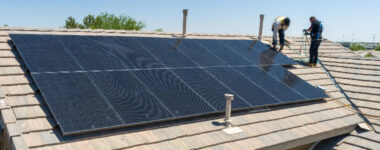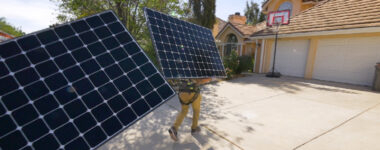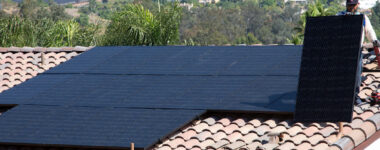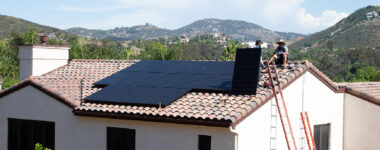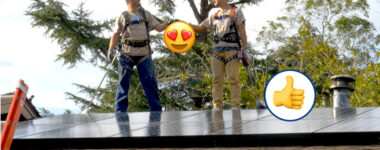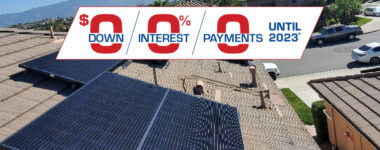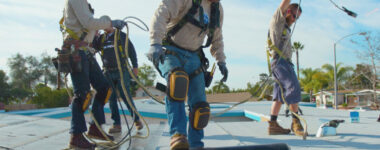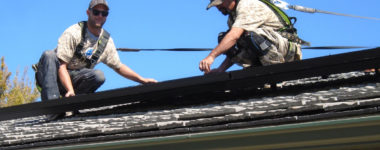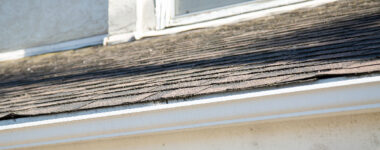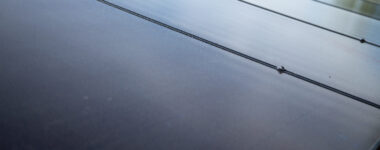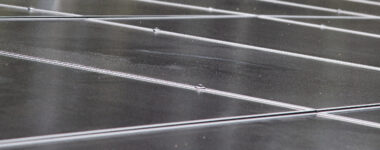Semper Solaris Blog
Investing in solar panels is a big step. While the promise of having control over your utility bills is tantalizing, the last thing you want is a massive maintenance job on your hands. So what’s the hard-hitting truth? Will solar panels require a lot of maintenance once you get a system installed? Generally speaking, you can expect very minimal maintenance requirements for a home solar panel system. With the average lifespan of a system ranging between 25 and 30 years, panels are designed to be very durable and resilient against the elements. To enhance the performance of your solar panels, you can expect to simply wash and clean off any dirt / dust several times a year. By taking small steps, you can ensure that your panels are able to capitalize on the power of the sun as much as possible to power your energy needs. Tips for Keeping Your Panels Clean Clear any large debris, such as leaves or branches, as soon as possible to avoid damage Remove dust and dirt from panel faces with a garden hose Aim to clean panels in early morning or late afternoon, when panels are least hot – spraying cool water onto the panels when at high temperatures could result in damage Consider installing a cleaning system to ensure regular cleaning (similar to yard sprinklers) Schedule a solar panel cleaning with your solar panel provider or a local expert if areas are too high / dangerous to reach Why Solar Panels Offer Peace of Mind As a Semper Solaris customer, you can be confident we use the best quality solar panels from the top manufacturers around. Their 25-year warranty is unmatched by any other solar panel manufacturer on the market. Every system is completely designed, engineered, and manufactured by Panasonic, SolarWorld, and Silfab, making them the most efficient and reliable panels available. You can expect greater power and greater savings. More than that, you can expect durability for limited repairs and solar power maintenance. In fact, the whole Equinox system (not just the panels) is covered by their 25-year warranty – that includes performance, labor, and parts. Repair or replacement of defective panels is provided to customers are absolutely no extra cost, without the burdensome requirement of a written claim or proof of purchase. Maintenance of your solar panels never looked so easy! Semper Solaris wants to make going solar simple. Maintenance isn’t something that should hold you back – if you want to learn more about finding a professional who can install and maintain your solar panels for optimal performance, reach out to our team today!
It seems like common sense that installing solar panels for your house can boost its overall market value and make your home more appealing to potential homebuyers. Solar panels reduce energy bills, create more sustainable energy and last for years—what’s not to like? However, until recently, there wasn’t definitive proof that solar panels resulted in added home value. Learn how the investment you make today in solar panel installation can make your home up to $17,000 more valuable when compared to homes without solar panels. The Financial Impact of Installing Solar Panels for Your House In 2015, the Orlando Lawrence Berkeley National Laboratory released a study asking an important question: are homes with solar panels really more valuable than homes without them? And, as you might imagine, the answer was yes! The study was supported by the U.S. Department of Energy and also had help from the National Association of Homebuilders and the California Energy Commission. It spanned eight states and was conducted over ten years, 2002-2013, meaning that it included data from the housing boom, bust, and recovery. It studied over 20,000 homes, with nearly 4,000 homes that included solar panels. Even the New York Times acknowledged the study’s significance for home appraisers and buyers. This research looked at all sorts of homes, valued from $165,000 to $899,500, with an average value of $473,373. The average home included in the study was also 2,334 square feet, on roughly half an acre of land, and was built near 1993. The average solar panel system on these homes was about 2.7 years old. The average home in the set of data without solar panels was similar in size and age—but was valued at about $456,378. That’s nearly $17,000 less than homes with solar panels! Interestingly, solar panel premiums stayed consistent throughout the housing market upheaval of the 2000s, suggesting that solar panels are a constant, reliable value even when everything else is up in the air. Not only were homes roughly $17,000 more valuable with solar panels, but the study showed definitively that buyers were willing to pay a $15,000 premium for homes with solar panels installed. These buyers were likely considering the long-term positive effects of their purchase: dramatically reduced electric bills for the foreseeable future, and an added value to their home that would unlikely to depreciate if housing markets were in trouble. In the end, solar panels for your house are a wise addition to any home, and especially with government incentives and future savings, their worth is often far above their cost. Get started on solar installation for your home with Semper Solaris. Go solar today!
Do you dream of building a new home in California? If you’re planning to break ground on your Cali castle any time after 2020, then you’ll need to add a new element to your plans – solar panels. That’s because the Golden State made history earlier this year by becoming the first state in the United States to require solar panels on all new California homes. What’s in the fine print of this new rule, and how will it affect that dream home of yours? Most importantly, will it be a boon or a bust for your wallet? California Makes Solar History To some degree, California’s revolutionary new rule isn’t such a surprise. For decades, our state has led the charge on adopting renewable energy and passing audacious clean energy legislation. In 2015, Governor Brown signed a law mandating that California receive at least half its electricity from renewable resources. (It looks like we may hit that goal 10 years early!) Of all the renewable energy sources available, California has fallen the hardest and fastest for solar panels. By the end of 2017, our sun-soaked state received almost 16 percent of its power from solar, compiling a solar photovoltaic capacity of 19.8 gigawatts. That’s more than four times the amount of its nearest competitor (sorry, North Carolina)! That’s why is wasn’t so surprising that on May 9th of this year, the California Energy Commission unanimously voted to require all new homes to include solar panels starting on January 1st, 2020. How will this new requirement work? Let’s dive into the fine print. Understanding the New California Solar Panels Requirement First and foremost, the new requirement only affects homes built after January 1st, 2020. If your current home does not have solar panels, or if your home is under construction, you don’t have to worry about this rule. However, many of us plan or at least hope to move into a new home someday. So, what does this rule mean for you? Purchase or Lease Solar panels are expensive. Fortunately, this new rule allows new home buyers to purchase or lease solar panels, so you don’t necessarily need to pay out of pocket for your solar panel system. Leasing your system means that the solar panel company owns the panels and covers the cost of installation. The solar company then charges you a set rate for the amount of electricity you use. Leasing can still help you save money, because typical costs are lower than what the utility companies charge. Solar Array Size The mandated solar systems only need to generate a minimum of 2 to 3 kilowatts (kW) per month, depending on the home’s size. An average solar system size is between 5kW and 10kW. A 2kW system is relatively small and likely won’t cover the entire energy demand of a typical home. That means new homeowners may be surprised to still receive an electric bill in the mail each month, though it will be noticeably lower than what they were charged in their previous, non-solar home. Shared Solar Systems The CEC’s ruling gives homebuilders two options on how they can meet the new regulation. They can either install solar panels on each new home they construct or build a “shared solar-power system” that can power a group of homes. This shared system might be ideal for condo complexes and possibly even larger planned communities. It will be interesting to see if this option creates a new shared solar-power system trend. How Will the New Rule Affect Me? So, we’ve outlined the CEC’s new rule and looked more closely at how it actually works, but that doesn’t answer your most pressing question. How will the solar panel mandate actually affect the cost of your future dream home? Let’s look at the nickels and dimes. According to the CEC, the new solar panel system will add around $9,500 to the cost of each new home. This is a serious pile of change, especially considering that California already has one of the most expensive housing markets in the country. But don’t write off that dream home yet! Though you may end up paying more upfront for your home after 2020, the CEC believes that this new rule will actually result in significant cost savings for California homeowners. According to the CEC, “For residential homeowners, based on a 30-year mortgage, the Energy Commission estimates that the standards will add about $40 to an average monthly payment, but save consumers $80 on monthly heating, cooling and lighting bills.” Put another way, the rule will give California households an expected savings of $19,000 over 30 years. How Will This Rule Affect California? While it’s great to save money on your energy bills each month, it’s important to recognize that this new rule has a higher purpose. A state filled with solar-powered homes will help California meet its ambitious renewable energy goals. California builds about 80,000 new homes a year. Currently, less than 20 percent of those homes include solar panels. The CEC estimates that solar energy generated as a result of the new rule would be equivalent to taking 115,000 cars off the road! Solar Panels Now or Later Solar panels in California have gone from being an affectation of the wealthy to becoming mainstream throughout the state. The CEC’s new rule only speeds up a trend that was already occurring. In fact, other states may follow suite. According to the New York Times, New Jersey, Massachusetts, and Washington D.C. are actively considering similar legislation. If you plan on building a home or buying a newly built home after 2020, then solar energy is going to be part of your life. However, it might be worth considering solar panels for your current home now. After all, when you get ready to sell, solar panels will be much more commonplace. You might actually be at a disadvantage if your home doesn’t have a solar system. If you’re ready to invest in solar panels in California to save on your energy costs and help our state meet its ambitious renewable energy goals, give us a call today. We have opened locations throughout California and are happy to offer homeowners a free energy analysis to help you determine if solar panels are right for your budget and energy needs.
In San Diego, the vast majority of solar panels are installed on rooftops. This makes sense, as roofs offer lots of surface area with unobstructed access to the sun. If you are considering investing in solar panels, the state of your roof will factor into your decision. If your roof requires repairs or is nearing the end of its life, you may first need to address these San Diego roofing issues before moving forward with solar panel installation. Here are some of the most common roofing questions we get from San Diego homeowners interested in solar panels. Will I Have to Buy a New Roof in Order to Get Solar Panels? Ideally, the life of your roof should match or exceed the life of your solar panels. Today’s top solar panels offer 25-year warranties, but some industry experts predict that solar panels can continue to operate (albeit with declining efficiency) for up to 40 years or more. One of the most popular San Diego roofing types is Spanish tile, which has among the longest lifespans of any roofing system. You can expect your Spanish tile roof to last up to 50 years, which means that if your roof is less than 10 years old, it may be a great candidate for solar panels. Slate and other forms of tile roofs also boast a 50-year lifespan, while wood shake roofs will give you 30 years of life, and asphalt shingles will only last 20 years on average. If your roof is nearing the end of its life, it makes sense to replace your roof before installing solar panels. New roofs are expensive, but it will cost you even more if you have to take down your solar panels after just a few years and then re-install them on your new roof. Additionally, older roofs may not be structurally sound enough to safely support a solar panel system. Will It Be Possible to Repair My Roof Once I Get Solar Panels? A roof is much more than the tiles or shingles that we see from the outside. A roof is actually a complex system that includes important components, such as the underlayment and flashing. All sorts of roofing issues can arise, such as cracked tiles, punctures in the underlayment, or warped flashing that causes water to collect on the roof. In a best-case scenario, you want to address and repair any major roofing issues before you install solar panels. A quality solar installation company should perform a full roof assessment and let you know if any issues exist before they start working. If your roof is already damaged or weakened, installing solar panels can make the problem much worse. What happens if you discover roofing damage after your solar panels have already been installed? In most cases, it is possible to repair roofing problems after solar panels have been installed, but it isn’t always easy. The solar panels may need to be detached from the roof and then re-installed after the damage is repaired. This can end up costing thousands of extra dollars, and the more time workers spend on your roof, the more wear and tear they cause! It is a good idea to get a full roof assessment from a roofing contractor in San Diego before moving forward with your solar panel installation, especially if your roof is more than 10 years old. Are Some Roofs Better Than Others for Solar Panels? If your roof is too old, has damage, or is structurally unsound for another reason, it may not be possible (and definitely not recommendable) to install a solar system. Assuming that your roof is in good shape, there are certain factors that make some roofs better for solar panels than others. By “better,” we simply mean that the solar system will be more efficient, generating more energy per panel. Orientation South-facing roofs get the most sunlight in North America, which will increase the energy efficiency of your panels. At the same time, west-facing panels tend to generate energy when the demand from homeowners is highest. For this reason, most solar installers will try to install south- or southwest-facing panels. If you have a northeast-facing roof, not to worry. You can still benefit from solar panels, but they may be less efficient, which means you may have to purchase a bigger system. Shade/Obstructions Another factor to take into consideration is the amount of shade that hits your roof. If a large tree in your backyard casts shadows across your solar panels, that will affect the efficiency of your system. It would probably be a good idea to trim the tree. If your house is up against a hill, or your neighbor just added a second-story addition that throws shade on your single-story roof, those will be more difficult problems to address. Pitch The pitch of your roof also plays a role in how well your solar system operates. The pitch refers to the slope of your roof. Steep roofs make installation difficult, while flat roofs require more racking so that panels can be angled to catch as much sunlight as possible. The ideal pitch of a roof is 30 degrees. Size Bigger roofs give installers more options on where to place solar panels, so they can get as much sun and produce as much energy as possible. It’s also important for installers to avoid installing panels in a way that interferes with the flashing on the roof and to keep panels away from heat vents and roof ledges. Smaller roofs offer fewer options and may not have enough space for a full solar system. In these cases, homeowners may need to purchase more efficient solar panels, which will be smaller, but can also cost a premium price. Don’t let these different factors scare you away from solar panels. The truth is that there is no perfect roof. If you have a north-facing, super steep, small roof, a solar panel system should still provide you with significant energy savings. Just be sure to speak with a solar installation expert to understand how your roof’s characteristics will affect the cost, efficiency, and size of your solar system. Will Solar Panels Ruin My Roof? Maybe you’ve heard a horror story from a family member or a friend who had solar panels installed only to discover that the installers left behind major (and expensive) roof damage. Unfortunately, this does happen, especially when homeowners don’t pick an experienced and well-regarded solar installation company. The truth is that many solar companies don’t have specific roofing experience or knowhow. They may crack or damage tiles, drag racks across your shingles, drop tools that puncture the underlayment, on install solar panels that block your roof’s flashing system, which can then cause water to puddle on the roof. In other cases, a solar company may not recognize pre-existing roof damage and then exacerbate that damage when they install your solar panels. Experienced solar companies know how to install a solar panel system without damaging a roof. It is up to you as a homeowner to do your homework before choosing your installer. One of the best things you can do is read reviews from a company’s previous clients. Solar and Roofing Services in the Same Place Your roof is the foundation of your solar panel system and plays an integral role in how well your solar panels operate. Often, Roof Installation or replacement go hand-in-hand with solar panel installation. That’s why you should consider hiring a solar installation company that also has expertise in Roof Installation and replacement. At Semper Solaris, we are experienced and licensed roofing contractors in San Diego as well as solar installers. Many of our clients appreciate that we can provide a roof assessment, Roof Installation, and even roof replacement as part of our solar services. By using the same company for your San Diego roofing needs and solar installation, you can save time, money, and headaches on these important projects. Want to learn more? Take a look at our roofing and solar discounts, and then contact us for a free roofing and solar consultation.
Are you ready to embrace the solar revolution and get solar panels for your home? Solar power in San Diego is a big investment that will affect your monthly energy costs and impact the value of your home. That’s why it’s so important to choose the right solar installation company. You have many solar installation companies to choose from in San Diego, but how do you find the right one? Every solar panel company will be more than happy to point you to their testimonial page, which (surprise, surprise) is usually filled with ecstatic praise. How can you find honest, unbiased customer reviews to help you determine if a solar company in San Diego is a diamond or a dud? Why Reviews Matter Solar energy in San Diego is big business, and a lot of companies are jumping on the solar installation bandwagon. One of the best ways to determine if a solar installation company will do a good job for you in the future is to find out how they’ve performed in the past. If a company has done shoddy work for previous customers, chances are they won’t miraculously change their behavior and provide you with an excellent result. This is why reviews are one of the most useful tools for evaluating and ultimately choosing a solar power company in San Diego. What to Look for in Reviews When you begin searching for solar company reviews, you may be surprised by how many you find. Top solar companies may have hundreds of reviews. How do you evaluate each of these reviews and effectively compare them with the reviews of a different company? Keep in mind that reviews are a tool that you can use to better understand the characteristics, strengths, and benefits of each company. When reading reviews, here are some important factors to look for: Location Is the company national, or is it local? If the company has multiple offices, make sure to read reviews for the nearest location to you. It’s important to ensure that a solar installation company has worked in your area, understands the popular roofing styles in your region, and is well-versed in the local permitting rules and regulations. Communication Good communication is at the heart of every successful solar installation. While you read a company’s reviews, look for indications that the company thoroughly explained the installation process to the homeowner and guided them in choosing the solar system size and the best financing option. Look for notes on if the company answered all the consumer’s questions and responded quickly to their concerns. Timing This one is simple. Was the company able to send a team out to perform the installation in a timely manner, and did the company meet its deadline? Budget Did the reviewer feel that the company listened to and abided by their budget requirements when recommending a solar system size and the brand of solar panels? Did the company stay within the budget? Problems Even if a solar company does everything right, problems and other surprises are still bound to happen. Maybe there’s an issue pulling a permit, the solar panels don’t arrive on time, or the project manager discovers a roofing issue that needs to be repaired. The true test of a company is how they handle the unexpected. When problems arise, did the company communicate with the homeowner? Did they provide solutions? Was the homeowner ultimately happy with how the problem was resolved? Overall Satisfaction When reading the reviews, note how many customers were happy versus unhappy. The best endorsement a homeowner can give is to say that they would recommend a company to their family and friends. Company Response Even the best solar companies can’t satisfy everyone, and not every homeowner has reasonable expectations. Just because a company has a few bad reviews doesn’t necessarily mean that it should be taken out of consideration. Most review sites allow companies to respond to reviews. If a company has one or two particularly bad reviews, take the time to read their response (a good company should respond to all negative reviews). This will give you a chance to understand their side of the story. Where to Find Solar Company Reviews Now that you know why reviews are important and what to look for in reviews, there’s just one more thing you should know – how to actually find reviews of solar installation companies! Fortunately, you have plenty of options. Here are the top four review sources that can give you great insights into your local solar power companies in San Diego. Better Business Bureau The Better Business Bureau (BBB) has been around since 1912 and is one of the most trusted and well-respected consumer protection institutions in the world. It allows consumers to write reviews of companies and file complaints against companies, which the BBB will then attempt to resolve. It currently includes more than four million consumer reviews. Businesses can seek special accreditation from the BBB, which signifies that they agree to abide by the BBB’s strict ethical standards and agree to be monitored for compliance. We strongly encourage consumers to only work with BBB-accredited businesses when possible. Accreditation shows that a business is serious about providing the very best customer service. Where We Stand: Semper Solaris has been accredited by the BBB since 2013 and currently has an A+ rating with the organization. See our BBB reviews. Angie’s List Angie’s List is a customer review site that specializes in gathering reviews for home service companies, including plumbers, remodeling contractors, and solar installers. Angie’s List has a strong reputation for quality, honest reviews and takes a lot of precautions to remove fake reviews. For example, all reviews are vetted by the company’s staff, and members can only submit one review every six months. The company receives roughly 60,000 reviews every month for over 720 different services. Reviewers on Angie’s List can rate service providers on a number of factors, giving you a better sense of how the company performs in areas like Response Time, Professionalism, and Quality of Work. Where We Stand: Semper Solaris currently holds an “A” rating on Angie’s List for Price, Quality, Responsiveness, Punctuality, and Professionalism. We earned a Super Service Award in 2016. See our Angie’s List reviews. Yelp Founded in 2004, Yelp is the biggest crowdsourced review site in the U.S. The site has collected over 155 million reviews on just about everything you can imagine, from your favorite brewery to the doggy daycare down the street. Yelp can usually provide the highest quantity of reviews, but the site has also struggled at times to effectively filter out fake reviews. It also does not require reviewers to provide their names, which can lead to anonymous reviews that might not be entirely trustworthy. How We Do: With more than 200 reviews on Yelp, Semper Solaris has a 4.5 star rating (out of 5 possible stars). See our Yelp Reviews. SolarReviews As its name implies, SolarReviews is a company that specializes in the solar industry. While the company’s main business is providing solar installation company referrals to consumers, it also includes robust crowdsourced reviews of installation companies, solar panels, and solar batteries. SolarReviews also offers a “Solar Pro” accreditation program to help consumers pre-screen solar installation companies. The accreditation requires, among other things, that a company have at least three years of experience installing solar panels, possess the correct licensing, and achieve a satisfaction score of at least 4.5 out of 5 stars. How We Do: With more than 200 reviews, Semper Solaris holds a 4.9-star score with SolarReviews. We are also proud to be an accredited Solar Pro and to be ranked as one of the company’s top 10 solar installers for 2018! See our reviews on SolarReviews. Do Your Solar Homework Don’t trust your solar panels and your roof to an unknown company. Check out their reviews. Any solar energy company in San Diego can slap a couple of positive (and possibly edited) customer testimonials on their site. The true test of a good installer is whether they invite you to check out their reviews on crowdsourced sites, like the BBB, Angie’s List, Yelp, and SolarReviews where they can’t pick or edit the reviews. The best companies, in the end, will earn the best reviews. At Semper Solaris, we work extremely hard to make sure every customer is thrilled when they choose us to install their solar power system in San Diego. Our great customer service has resulted in hundreds of positive reviews and high rankings on every major review site. We invite you to read all of our reviews and then to schedule a no-pressure, no-cost energy analysis. We hope that you’ll be writing a great review of our service someday soon!
The first question almost every homeowner wants to know when they’re thinking about going solar is – how much are solar panels? A solar power system is a big investment, and cost can be a deciding factor for many homeowners. Solar power system costs will depend on a number of aspects, including the size of the system, the solar panel brand, and where you live. Why does location matter? Which states are the cheapest to go solar, and which are the most expensive? Let’s take a look at how state policies affect solar costs and where California lands on the solar cost spectrum. How Much Are Solar Panels in California? California is known as “The Golden State,” but it could just as easily be dubbed “The Solar Panel State.” California is the number one solar state in the country, producing enough solar energy in 2016 to power almost five million homes. Since California loves solar so much, you’d think that the cost of a solar system in the state would be among the lowest in the country. You’d be wrong. According to SolarReviews.com, the average cost of a 5kw (kilowatt) system in the United States is $10,800 after taking the federal tax incentive into consideration. (In this article, we’ll stick with the 5kw size in order to maintain consistency when comparing costs.) How does California stack up against the average? The average cost of a 5kw system in California with the tax incentive is $11,130. That places California above average for solar costs when compared to other states. Not exactly something California homeowners want to see! In contrast, the three cheapest solar states are: Georgia: $9,730 for a 5kw system Arkansas: $9,940 for a 5kw system Alabama: $10,150 for a 5kw system Of course, things could be worse for California residents. The two most expensive solar states are: Hawaii: $11,970 for a 5kw system Connecticut: $11,830 for a 5kw system What is behind these big pricing disparities in solar power system costs? Why does it cost almost $1,500 MORE to install the same sized system in California than it does in Georgia? The answer, it turns out, has to do with wages, living standards, and the specific rules and regulations in each state. Worker Wages If you or a close friend or family member owns a business, then you know that one of the most significant costs for almost every company is employee salaries and hourly wages. Solar panel installation companies are no different. A successful solar panel installation company relies on a big team of people, including installation specialists, site survey technicians, warehouse technicians, customer service representatives, office managers, and more. Each of these people represents a big investment by the company. And throughout the United States wages vary greatly. For example, California’s statewide minimum wage in 2018 is $11.00 an hour, one of the highest state minimum wages in the country. Additionally, local cities can set their own minimum wage. Two of the top five cities with the highest minimum wage in the country are in California: Oakland at $12 an hour and San Francisco at $15 an hour. Unsurprisingly, the minimum wage in Hawaii and Connecticut is also relatively high at $10.10 an hour for both states. How about the three cheapest solar states: Georgia, Arkansas, and Alabama? Of the three, only Arkansas has a state minimum wage above the federal minimum wage at $8.50 an hour. Employees in Georgia and Alabama must rely on the federal minimum wage of $7.25 an hour. Average Household Income Minimum wage is only one factor to take into consideration in understanding solar cost differences between states. Many of the workers employed at solar installation companies have specialized skills. When the job market is incredibly tight, as it is right now (the unemployment rate in April 2018 was 3.9%), employers have to pay more to keep good employees. These employees expect to be paid a salary that is in line with norms for their area. Median salaries, like minimum wages, are drastically different across the country. Anyone who has lived in California for any length of time knows that the cost of living is high in our state. As a result, incomes also tend to be higher than average. The median income in California is $64,500. It’s even higher in the most expensive solar states. In both Hawaii and Connecticut, the median income is over $70,000. Contrast that with our cheapest solar states. In Georgia, the median income is just over $50,000. It’s less than $45,000 in both Arkansas and Alabama. In high cost-of-living states, like California, Hawaii, and Connecticut, employers have to pay their employees more in order to stay competitive and build a great team. These costs and are often passed, in part, onto customers. While this may mean more money out of your pocket if you invest in solar panels in California, Hawaii, or Connecticut, here’s a better way of thinking about it. The extra money you’re paying goes into the paychecks of the people installing the solar panels on your roof so that they can afford to live and raise their families in your town. This is why we always encourage homeowners to work with a local installation company. Keep your dollars in your community! Licensing Requirements Licensing requirements also vary from state to state and can affect how much solar panels are in your state. In some states, solar installers must get a separate, specialized solar contractor’s license, which requires additional costs. In other states, solar installers must have certain voluntary certifications in order to qualify for local incentive programs. California requires solar installation companies to have a contractor’s license, such as the C-46 Solar Contractors License as well as specialty licenses for PV and solar thermal installation. Contractors must also maintain their license by investing in ongoing training and education, which requires time and money. Not every state demands such strict requirements. For example, Georgia does not require solar contractors to hold any state licenses, and solar companies are not regulated by the state licensing board. This means that anyone in Georgia can call themselves a solar installation company and install panels on your roof. Sure, the cost of solar panels in California may be higher than in Georgia, but at Semper Solaris, we think our customers appreciate the fact that fully trained and licensed contractors are working on their roof! Solar Panels Are an Investment Some California homeowners get a bad case of sticker shock when they find out how much solar panels are, especially compared to other states. Our hope is that this article explains where those extra costs come from. The extra costs you pay go, in large part, right into the paychecks of the company’s workers so that they can earn a fair wage. Additionally, some costs are used to maintain the contractor’s training and education so that they can remain fully licensed. We think those are good investments and hope you do too. At Semper Solaris, we recognize that solar panels are a significant investment for many of our customers. We do our best to mitigate these costs by offering special discounts, including savings for veterans and first responders. We also offer multiple finance options, including zero-down financing. Don’t let the cost of a solar panel system scare you away from solar. Solar panels will save you money in the long run by cutting your energy bill costs. Ready to learn more about your options? Schedule a free energy analysis of your home today!
Your roof plays a vital role; not only does it protect your household from exposure to the elements, such as sunbeams, rain, and biting winds, but also helps keep you cool in the summer and cozy in the winter. Energy efficiency and element protection are the two key roles of your roof. What happens when you notice a leak? Should you panic and start scheduling a total roof replacement? No, not necessarily, but you definitely shouldn’t overlook it or put off on getting it inspected. Roof leaks don’t have to be complicated or extremely expensive. In fact, most cases of leaks can be resolved in quick and effective repairs. However, things get pricier and more difficult when homeowners delay or ignore leaks for long periods of time, allowing the damage to increase while the problem festers. We’ve outlined some serious reasons you should act quickly if you spot a leak below. Structural Damage – Let’s talk about the obvious one first. A leak can cause damage to your attic area, as well as your ceiling, floors, and furniture. This may mean you need to replace insulation, fix bubbling ceiling plaster, repaint the ceiling, replace drywall, remove and replace ceiling fixtures (fans and lights), or even replace flooring in certain areas if the damage goes unchecked. Unwanted Mold – Nobody likes the idea of mold or mildew developing in their home, especially if they could have put a stop to it. Mold can pose a serious health risk, quickly spreading through an HVAC system / venting. You may be looking at ruined carpet or furnishings if mold or mildew are spread without any action. The U.S. Environmental Protection Agency has made it clear that mold growth in a home can result in health problems or aggravated health issues, from asthma to allergies. Electrical Hazards – While a water leak may seem like the last thing that would lead to a fire, this is a serious threat when you have electrical wiring in your ceiling or attic area. A consistent water leak may lead to a home fire due to wire shorting, which is why you never want to ignore a leak, even if it seems harmless or like it is causing minimal visible damage. Throwing Away Money – Leaks can cause damage to your home’s insulation, which means a spike in energy bills (as well as the costs to fix the leak, add new insulation, repair any structural damage etc.). The longer you put off a roof leak, the more problems you could end up having to deal with. Higher utility bills are the last thing you want to deal with on top of a Roof Installation! If you’ve noticed a leak in your roof and want to get to the bottom of it, waste no time in calling on your local roofing experts. Start by scheduling an inspection of the area to ensure you get a clear idea of the damage involved and what steps you will need to take to fix it, whether it is simply structural or involves some additional work outside of your roofer’s jurisdiction. Semper Solaris has been faithfully serving customers throughout Southern California and beyond for numerous years. We tackle roofing projects big and small and can help you get to the bottom of your roof leak. Contact us now to talk about your Roof Installations.
Summer in Southern California can be a wonderful time. The weather is warm enough to enjoy long days at the beach, early morning hikes in the hills, or relaxing poolside afternoons. While you are enjoying a break from the sun inside your home, your roof is experiencing constant exposure. Since we don’t have very harsh winters here in San Diego and surrounding areas, the summer is when your roof’s job kicks into high gear. So what can you do to make sure your roof gets the job done and doesn’t suffer any unnecessary damage? Keep Your Gutters Free of Debris During the fall and winter months, plenty of debris can begin to build up on your roof, especially in the gutters. Most people make sure to keep these areas clean during the rainy season, but may forget that warm summer weather can lead to debris and falling leaves as well. From leaves to twigs and rocks, a moderate summer breeze could be blowing in more debris than you’d imagine. Keeping your gutters clean during the summer is crucial for your roof’s overall health. Another solution would be to install gutter guards to help prevent this debris from building up in the gutters. Do a Quick Shingle Head Count Harsh winter winds and rainstorms can do some damage to your roof, even if it is very minimal. This minimal damage may look like loose shingles or tiles that end up being blown off your roof. While exposed spots may seem like more of a problem in the rainier months, there is just as much potential for damage in the summer. Mold and mildew could begin to develop. Take advantage of the clear skies in the summer to check for any missing, warped, or damaged roof materials. You can then schedule moderate repairs or get a professional roof inspection to see how bad the damage is. Get Your Attic in Order While you may not always think of your attic and your roof as going hand-in-hand, they definitely do. If you want to keep your house cool over the summer and do everything you can to help your roof get the job done, making sure your attic is in order is important. Some simple things you can do include checking on your exhaust fan and vents, inspecting your attic for insulation issues, and sealing up any cracks or potential air leaks. Schedule a Seasonal Inspection Not one to embark on a major DIY project in the summer? We get it. Truthfully, we appreciate it when our customers leave the roofing inspections and repairs to the professionals – it makes our jobs easier and ensures their safety and satisfaction! Semper Solaris would be happy to send out our roofing experts to take a look at your roof before the summer sets in. If you can’t remember the last time you scheduled a roofing inspection, there is no better time to check this home improvement project off your list! We’ll make sure to give you a clear picture of your roof’s health and help you determine the right steps moving forward, from repairs to replacement. Our experts work with top quality products from well-known manufacturers, from GAF to Owens Corning. We’d be honored to help you tackle your summer roofing improvements. Reach out to our San Diego roofing company today to set up an inspection.
A home’s roof is a key aspect of defense from the elements, whether it be sun exposure or torrential downpours. More than that, a roof helps a home maintain energy efficiency. How can you tell if your roof is getting the job done or costing you serious dollars in energy waste and in need of replacing? While there is plenty information available on how long an average roof is supposed to last, there are too many variables for any online resource to give you an exact answer on your roof lifespan. The good news? Semper Solaris is here to provide you with some clear-cut signs that it is time to call on the roofing experts. You may not be able to tell exactly what is wrong with your roof, but these signs should help you determine that you need to get a San Diego roofing company out to inspect your home’s roof ASAP! Signs It's Time to Call Your Local Roofing Experts Homeowners know that the health of their roof can have a major impact on the health of their entire home. Leaks can cause damage to property, allow mold and mildew to develop, and lead to spikes in energy consumption. But how can you tell that your roof is in need of inspection and possible replacement? Keep an eye out for these typical signs that your roof may have passed its prime: It’s seen one too many years – if your roof is 20+ years old, it’s time to get a serious inspection There are noticeable bald spots due to missing or damaged granules You’ve spotted water damage or leaks There are obvious cracks or spots where shingles are missing Mildew building up in certain areas Some shingles are starting to curl or buckle Moss and / or algae have started growing on shingles Sagging spots in the roof You are able to see sunbeams in your attic Have you started to see any of these warning signs? More than one sign? Don’t try to resolve the problem without a professional! When you get a roofing inspection, you can better understand the issues and determine whether simple repairs are the way to go or a total roof replacement is needed. Get the Ball Rolling on a Roof Replacement We want to make things simple for our customers, which is why we offer free quotes on new roofs. Think it’s time to get your roof inspected and possibly replaced? Our San Diego roofing company is your local source for quality services! We offer a range of roofing systems, from wood shingles to tile roofing to asphalt shingles. We’ll walk you through your options and make sure you find a roofing system that makes for your budget and preferences.
We all know that roofing inspections are important, especially if you want to do any upgrades (like adding solar panels) on your home to make it more modern or energy efficient. Having regular roof inspections done on your home can be a great preventative maintenance method, helping you avoid costly repairs or replacement roofing in the long-run. The questions we often get when scheduling a roofing inspection usually have to do with what a homeowner can expect. Semper Solaris prides itself on providing top quality, professional roofing inspections. Our goal is to provide customers with an honest and clear assessment of their roof’s current condition. That is why our inspection process looks a little like the following: The Interior Inspection Process Typically, signs of roofing problems show up in the interior of a home, particularly the attic. We will always perform a thorough inspection of your home interior areas for optimal insulation, ventilation problems, and potential moisture (and mold / mildew) threats. These areas can all be key indicators of your roof’s health, which is why we never underestimate the interior assessment. If we notice any issues, we will quickly alert you and get working on the best possible solution. The Exterior Inspection Process Of course, the exterior inspection also provides critical insight into the health of your home’s roof. We will send our qualified roofing inspection team onto your roof to do a thorough assessment. Some of the things we look for include aging and weather damage to roofing materials, leaks, areas missing shingles, loose materials, and more. Overall, we are looking to get an accurate picture of your roofing system’s status so we know if you need a roof replacement, upgrades, repairs, or just some minor fixes. We also take a look at other areas around your roof that are vulnerable to developing leaks or drainage problems, ensuring all components are in tip-top shape. Creating Customized Roofing Solutions The final step of the roofing inspection process is to follow up with customized solutions for any issues found, whether interior or exterior problems. Our team works with you to outline a plan to take care of any roofing upgrades on your schedule and within your desired budget. We also make sure you have a clear understanding of any costs upfront. We never leave you in the dark in regards to the cost of a project! Semper Solaris knows that a durable, lasting roof is comprised of much more than just quality materials. We make sure to create comprehensive roofing systems that take every detail into account, from waterproofing barriers to ventilation. You can count on our team to think of it all, including sun exposure issues, insulation, starter shingles, and everything in between. Set up a roofing inspection with the right team today. We are always just a phone call away.
What do you really know about attic ventilation? At Semper Solaris, we have noticed that there is a lot of confusion swirling around the role of a home’s attic when it comes to a roofing system. That’s why we want to debunk some of the most common myths we hear from people. Keep reading to get the low down on some attic misconceptions you may have bought into! Vents Are Only Important During the Warmer Months This myth has homeowners believing that they really only need good roof ventilation when the climate is warmer. Many believe that the main purpose of proper ventilation is improving energy efficiency. Though this is one benefit of ventilation, that isn’t its main purpose. In fact, things like home insulation, amount of sun your roof is exposed to, and even roofing materials will all be more impactful in regards to energy efficiency. So why is attic and roof ventilation important? It helps extend the life of your roof, helping warm air escape properly in the winter and keeping your roof evenly vented to keep your roof and attic cool in the summer. This does play a part in reducing energy costs, as well as maintaining moderate indoor temperatures, rather than extremes. Roof Vents Mean You Have Good Ventilation Another myth that is often bought into is the idea that if a home has roof vents, then it has good ventilation. Unfortunately, it isn’t this simple. Various homes may require slightly different roof vent types as well. There are ridge vents, gable vents, and more to select from. That is why it is important to go beyond simply having roof vents and ensuring you have the right roof vents. Some vents are more affordable initially, while others are more effective in keeping the airflow going. Typically, the most effective roof ventilation strategy is to utilize a ride-and-soffit continuous system, which will be fine-tuned for each specific roof. The More the Merrier If vents are good for your roof and attic ventilation and efficiency, the more the merrier, right? Wrong. This myth has homeowners believing they need to be overly aggressive with ventilation. True, poor ventilation can lead to reducing energy efficiency, potential mold and mildew due to moisture build-up, and other issues, but loading up on vents can also cause damage. Each vent creates a vulnerability where leaks can occur, increasing the risk of moisture problems and other complications. When it comes to vents, you want to take the Goldilocks approach – not too few, not too many, but just right for your roof and attic. Proper attic ventilation can help promote optimal indoor air quality and ensure your roof is in top condition. Think your home ventilation may need an update? Talk to the roofing team at Semper Solaris today to learn how we can help!
The answer is yes, and that “future” just got a lot more real after the California Energy Commission unanimously voted in the new requirement this month. This is a major stride in improving the energy consumption and clean energy production in California. Under the new requirement that is set to go into effect in two years-time, all new homes must have solar power. While it is true that this will add upfront cost to new builds, state officials and solar power advocates alike agree that the additional building expenses will be covered down the road by the long-term reduction in energy bill costs. Further, California is required to have at least 50% of all electricity sourced from non-carbon-producing options, or clean energy sources by the year 2030. With solar panels being one of the most common and accessible clean energy options, it has become a major force in shifting the state towards alternative energy reliance. What Will the Added Cost Look Like? The new building code gives builders a little freedom when it comes to choosing how they would like to make solar power available on the properties. For example, builders have the option of either adding solar panels to each individual home or creating a shared solar power system that serves a group of homes or development. Likewise, new homeowners don’t have to see the full cost of solar panels added on to their home price, instead, they have the option to lease on a month to month basis. Generally speaking, estimates range from $8,000 to $12,000 in terms of what homeowners can expect to pay. If a homeowner had a 30-year mortgage, they are looking at adding $40 to their monthly payments on average. According to the Energy Commission, however, estimates show that consumers will save around $80 a month on their energy bills, thus making the move profitable for them. At the end of the day, moving away from a centralized source of power is better for everyone, especially homeowners. It gives those spending the money on electricity and energy bills more control over what they are spending, how much they are willing to pay, and who their providers are. Now, with solar power and battery storage solutions like Tesla Powerwall growing in demand, it helps lessen the dependency on grid power altogether. Those Without Solar Can Expect a Rise in Energy Costs California is leading the charge on solar power, standing as the top state in the nation in regards to solar capacity. As of 2017, solar power was responsible for covering nearly 16% of California’s electricity demands. Not only that, but the solar industry boomed, providing more than 86,000 jobs to workers across the state. While solar can be seen as a major positive force in the state, some current homeowners are wondering where the new building code will leave them. What if you didn’t have your home built with solar panels? Should you consider going solar even if you aren’t “required” to? The affordable cost of installing solar panels, as well as the incentives and many financial options, make it a very appealing option. Not only that, but new electricity rate structures are coming up that will start to charge California residents based on the time of day that they are using electricity rather than just a flat daily consumption. What does this mean? That homeowners that are using energy at “peak” hours could see major spikes in expenses due to these new time-of-use rates. Avoiding higher costs with energy-efficient features is becoming more and more attractive to many California homeowners. You can get started today by requesting a free energy-analysis from Semper Solaris today.
California homeowners are becoming more aware of the advantages offered by solar panels. With the great amount of savings and affordable installation costs, solar panels provide an appealing means for residents who want to cut back on energy usage and spending. That’s why many corporations, small businesses, and religious organizations are also investing in solar panels. In fact, many synagogues have already taken advantage of solar panels. Switching to solar energy can be a mitzvah and an act of tzedakah, which is an obligation to act for social good. Switching to solar panels can additionally allow for extra savings to be put toward charitable causes. What to Consider When Switching to Solar Stay local - Opt to work with a company you can get to know and trust to work on your project. That means keeping it local and investing back into your own community. Semper Solaris is a veteran-owned and operated company with military roots and a customer-first mindset. We operate based on trust, keeping your best interests our top priority. Stick with a fair labor standards manufacturer - Solar panel manufacturing can vary. It is important to find a manufacturer that you can have peace of mind about providing solar panels for your synagogue. Semper Solaris uses American-designed solar panels dedicated to environmental responsibility and sustainability. Keep your project cost effective - Switching to solar can quickly become a bigger-than-needed expense. Strategically laying out your installation options protects your investment. Semper Solaris helps you benefit from all possible credits and savings, offering the most affordable solar options in California. We are here to make sure that your decision is economically viable while being environmentally responsible. Being a member of a congregation carries responsibility to your fellow worshipers and to the rabbis and cantors who lead them. To recommend sustainable energy in the form of solar panels is a good work, a mitzvah. Want to learn more? Contact Semper Solaris to get started on solar installation at your synagogue or temple.
The sun is one of the most powerful energy sources known to man. It provides us with warmth and is a vital energy source to help plants, trees, and flowers grow. The sun is also one of the most efficient forms of energy. In fact, this ultimate solar energy system allows us to harness the sun’s energy to heat, cool, and provide electricity for our homes and businesses. Most people take the sun for granted, but it’s so much more than a bright, shiny object in the sky. Without the sun, humans wouldn’t be able to survive. Learn more about our special sun and how it serves as the ultimate solar energy system. Fun Sun Facts for Kids The Sun by the Numbers Most people just take the Sun for granted and just simply acknowledge that it is there. But the Sun is more than just a bright shiny object in the sky. It is much more! The Sun is the center of our solar system, the object that other planets revolve around. It also is an important source of energy that can be used to heat and cool us. And, the Sun is also important that it provides physical and mental health benefits by just being out. Without the rays of the Sun, we would not be able to survive. So, the next time, you go outside and see the bright sunshine, take a moment to appreciate all the things that our Sun provides us. To learn more about all that the sun does for us as the ultimate solar energy system, and the possibilities of California solar power, take a look at the following information. Practical Uses of Solar Energy Common Uses for Solar Energy Solar Energy Science Projects Solar Power Uses Renewable Solar Energy The Sun in Folklore The Sun in Mythology Sun Myths Solar Energy Resources Solar Energy Resource Center Solar Energy Basics for Kids
So you want to take advantage of all the gorgeous sunshine San Diego receives throughout the year to lower your energy bills and shrink your environmental footprint. Awesome! It’s time to start thinking about solar panels for your home, but what exactly does solar installation entail? You definitely don’t want to feel like you’re fumbling in the dark as you start this solar journey, so we’ve created this handy checklist to light your way. Our solar checklist lays out each step in the process, so you know exactly what to expect from start to finish. Step 1 – Make Sure Your Roof Will Hold Up Before you can put solar panels on your roof, you need to make sure your roof can handle the extra load. Materials Some roof materials are not conducive to solar panels, including slate and wooden roofs. Fortunately, here in San Diego, a majority of roofs are made with clay and Spanish tile, which are great for solar installation. Ownership If you live in a condo or townhome, your roof is probably owned by your homeowners’ association (HOA), and your CC&Rs likely do not allow you to make any modifications. In this situation, you can always lobby your HOA to invest in solar panels on behalf of all homeowners. Roof Size A small roof offers less area for solar panel placement. This may require you to invest in more efficient solar panels, which are smaller but also more expensive. Location Ideally, solar panels should face true south to receive the most direct sunlight. However, solar panels can still operate well (though less efficiently) on east- and west-facing roofs. Age Most solar panel systems can last an estimated 25 – 40 years. If your roof is on its last legs, it’s probably smarter to deal with that issue first! (Did you know we also repair and replace roofs in San Diego?) Shade The amount of shade your roof receives during the day can affect the efficiency of solar panels. If a big tree looms over your house or a taller neighboring house casts shade, your panels won’t work as well. Even if your roof isn’t ideal for solar panels, all is not lost. Old roofs can be replaced, or you can consider a ground mounted solar panel system. Step 2 – Determine How Much Energy You Use If order for a San Diego solar installation company to provide you with an estimate on your solar system, you need to determine the size of the system you want. To do this, you’ll need to work backwards and figure out the average amount of energy you need the system to generate each month. This may seem tricky, but it’s actually simple. You should be able to log onto the website of your electrical provider and download your statements for the last year. Each statement will list how much energy you used that month in kilowatt hours (kWh). Add up your energy usage from the last 12 months and divide by 12. This will give you your average monthly usage. You’ll want your solar system to generate this amount of energy for you each month so your solar panels can cover all your energy needs. Note: If you plan on increasing your energy usage in the future, such as by purchasing an electric car, make sure to take this into consideration when determining the size of your solar system. Step 3 – Select Your Financing Do you want to own solar panels for your home, or does ownership not matter as long as you don’t have to write a big check? You have a variety of financing options. You can purchase your panels outright, either with cash or through a loan. Most solar companies also offer solar leases and Power Purchase Agreements (PPAs). With solar leases and PPAs, the solar company owns the panels and charges you a set fee for your energy usage that is usually less than what you would pay the utility company. The upside of this arrangement is that you don’t have to pay a dime for your panels! Step 4 – Choose Your Solar Installation Vendor San Diegans have a lot of choice when it comes to solar installation companies. That’s a good thing! The best place to start your search is to ask your family, neighbors, and friends who have already invested in solar panels about the company they used. Another smart move is to check a company’s reviews on the Better Business Bureau, Angie’s List, and Yelp, so you can read what past clients experienced with them. Finally, we encourage you to work with a local company. Hiring local keeps your money in the community and supports local jobs and local families. Plus, local companies are invested in the community. They live and work here, so it’s in their best interest to do a great job for their neighbors. You should always get at least a few different quotes so you can compare and make the best decision for your project goals and budget. Price will, of course, be a factor in your decision, but don’t just choose the lowest-priced vendor. Make sure the company you pick has great reviews and a history of service in your community. Step 5 – Choose Your Solar Panels Your chosen solar vendor will probably have a few preferred solar panel brands that they recommend to you. Listen carefully to their recommendations, but know that you can choose a different brand. Premium brand solar panels tend to offer higher efficiency, better design, and a longer warranty, but you’ll also pay a premium price. Solar Reviews is a great resource for learning more about the dozens of available solar panel brands. They also host reviews from homeowners. Step 6 – Sit Back and Relax Once you’ve chosen your San Diego solar panel installation company, your financing plan, and your solar panel brand, it’s time for you to step back and let the solar company take the baton. Now it’s their job to: Order the panels and other equipment Pull all the necessary permits Install the mounting, panels, and inverter Receive permission to hook your panels into the local electrical grid Check the system and turn everything on A good solar company will walk you through each of these steps so that you understand exactly what’s happening and when. After the installation is complete and your solar panels are online, you’ll be able to check your meter to follow your energy usage. Most solar companies also offer monitoring software that lets you see how much energy your panels produced each day, so you can watch them work! We hope this solar installation checklist was helpful. If you live in California and have additional questions about solar panels for your home, let us know! We’d be happy to perform an onsite evaluation to determine if your home would be a good candidate for solar panels. We are proud to live and work here in San Diego and to employ veterans and San Diego residents.
